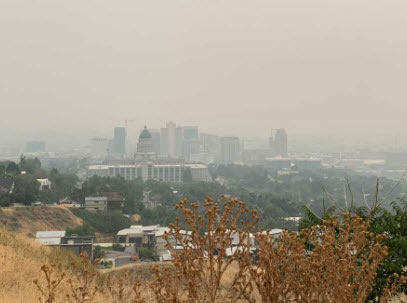- Principal Investigator: Dan Jaffe (University of Washington)
- Study Period: July 1, 2022 – June 30, 2023
- Funded by Science for Solutions Research Grant: $280,516
- DAQ Contact: Nancy Daher (ndaher@utah.gov)
The Salt Lake City (SLC) region is a designated non-attainment area for the 2015 8-hour ozone (O3) standard. Unfortunately, the annual fourth highest O3 maximum daily 8-hour average values have shown little change in the region over the last decade, despite a significant decrease in NO2 concentrations (Jaffe, 2021). At present, we lack a clear understanding of the chemical and meteorological controls on O3 in the SLC area and the relationship between SLC O3 and the increasing area of fires in the western U.S. The University of Washington, Utah State University, and the University of Montana propose to conduct a collaborative and detailed study on O3 and PM2.5 in the SLC area. We will measure a wide array of volatile organic compounds (VOCs) in the summer of 2022, including multiple smoke tracers. We will also measure O3 using a scrubber-less technology to look for possible biases in existing FEM O3 measurements during smoke events. Using these new VOC observations, plus existing measurements of NO, NO2, CO and particles with an aerodynamic diameter smaller than 2.5 μm (PM2.5), we will conduct a variety of analyses to understand O3 formation and the sources of PM2.5 in the SLC basin during summer. The primary goals of this work are:
- Make new observations that can be used to support policy-relevant modeling and analyses of O3 and PM2.5 in the Salt Lake City region.
- Evaluate whether existing FEM O3 measurements show a positive bias during smoke events.
- Evaluate and compare two different ways to identify smoke in an urban area.
- Quantify the range of concentrations of NOx, VOCs, CO and PM2.5 on smoke-influenced vs non-smoke days.
- Conduct photochemical modeling and statistical/machine learning analyses to improve our understanding of the sources of O3 and PM2.5, and O3 photochemistry (NOx vs VOC sensitivity) on both smoke-influenced and non-smoke days during the summer of 2022.
The project is a joint effort of three western universities and will be conducted from July 1, 2022–June 30, 2023. Measurements will be made at or near the SLC/Hawthorne site in August–September 2022, with the remainder of the project period used for data processing, calibration, evaluation, detailed analyses and modeling. At the completion of this project, we expect to have significant new policy-relevant insights on what controls high concentrations of O3 in the SLC region, in both smoke-influenced and non-smoke conditions. We will also provide recommendations for future research on O3 and PM2.5 in the region.


